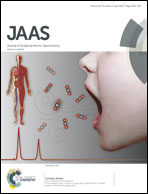Study of a direct current atmospheric pressure glow discharge in helium with wet aerosol sample introduction systems
Abstract
In this study a He DC atmospheric pressure glow discharge (APGD) is characterized under dry conditions and with the introduction of wet aerosols. The aerosols are generated by a conventional pneumatic nebulization system using a MicroMist nebulizer placed in a double pass spray chamber according to Scott or alternatively by a custom-built drop-on-demand (DOD) system based on printer cartridges. The experiments are performed at a He gas flow of 500 mL min−1 and 40 mA current. The influences of the H2O load on the discharge rotational temperature (Trot), excitation temperature (Texc) and the electron number density (ne) are determined. Temperature reductions when comparing dry and wet conditions are found to be around 500 K for the Trot and 240–400 K for the Texc. Detection limits for the elements Cd, Cu, Mg, Mn and Na are presented for pneumatic nebulization coupled to a continuous flow injection system. They are found to be between 10 μg L−1 for Na and 140 μg L−1 for Cu. In the case of the drop-on-demand system a value of 16 μg L−1 for Na was obtained. The applicability of the discharge to the determination of Na in a tap water sample at concentration levels of 20 mg L−1 is shown for both introduction systems and the accuracy of the results is found to be within 1.3 mg L−1 as compared to the result of inductively coupled plasma optical emission spectrometry (ICP-OES).


 Please wait while we load your content...
Please wait while we load your content...